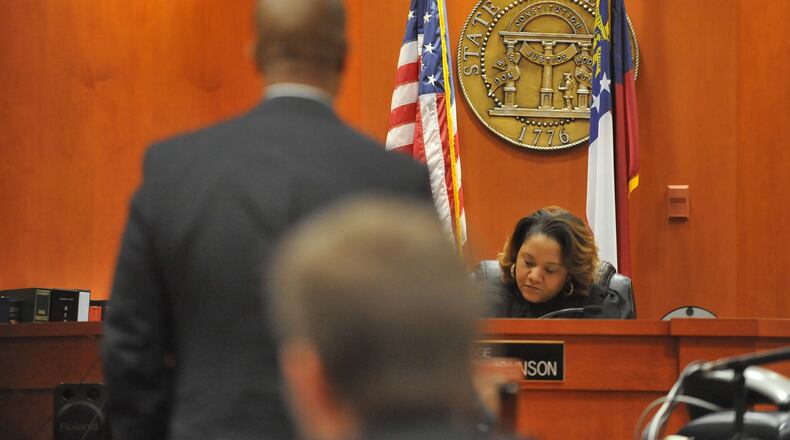No one is going to accuse judges of enthusiastically embracing modern society.
They speak in Latin phrases and trace much of their behavior from the bench back centuries to English common law. Plus, who else wears robes to work?
Yet daily they are forced to deal with Twitter. And Facebook. And Periscope. And a tide of technology — from laptops to smart phones and tablets — that can wreck a trial, intimidate juries and place witnesses in peril. Or so they say.
To deal with this, the Council of Superior Court Judges of Georgia this week approved a change to a courtroom rule that allows for electronic recording of trials. The rule was approved at a big conference of Georgia judges held this week at the King and Prince Resort on St. Simons Island. (Pricey, but you know, it's probably the only place they could get.)
The new rule ostensibly recognizes changes in technology that could jeopardize the fairness of judicial proceedings, but in reality it just makes the courts less open.
It’s an unfortunate rule that government transparency advocates have argued against — to no avail. And it rolls back what had been a fairly open system.
For years, members of the media wanting to photograph or electronically record and broadcast a trial filed a form called a Rule 22, named after the rule in the Uniform Rules of the Superior Courts. Typically, the judge in the case would review the request, and most often, grant access.
A judge might set conditions on where cameras could be placed or where media should sit or in particularly high-profile cases where a lot of requests were made, a judge might require broadcast media to choose a single camera and "pool" their coverage, often to protect the identities of jurors. But, by and large, the tradition and tendency has been to grant those requests pro forma. (See? Latin.)
But the members of the judges’ council recognize that anyone with a smart phone has the ability to record and broadcast a trial. Hence the new rule, which states that smart phones and other recording devices are to be turned off and cannot be used without advance permission from the trial judge.
And here’s why it won’t work.
A member of the Gangster Disciples is unlikely to be up to speed on the Uniform Rules of the Superior Court when he whips out a cell phone and starts to Facebook Live a witness in a gang case. Same goes for many a blogger or random citizen.
In fact, the only folks likely to know about Rule 22 will be lawyers, court officials and professional journalists. To make everybody else follow the rule, judges will have to make an announcement that recording is prohibited unless the judge says differently.
In fact, that’s in the preamble for the new rule: “A court must use reasonable means to advise courtroom visitors of the provisions of this rule.”
New bureaucratic procedure
The thing is that judges already do that.
Across the state, bailiffs patrol courtrooms prior to the judge’s arrival making sure no one has their phone out. Earlier this month, I was in a Fulton County courtroom with conspicuous signs reminding visitors that there was no recording without permission and two sheriff’s deputies were on hand for those with poor reading comprehension.
There simply is no need to rewrite the rules for this purpose because judges already have the discretion under current rules to maintain order and dignity in their court. Folks who violate a judge’s order can be removed and held in contempt.
Passing a rule specifically speaking to spectators that spectators will never read does not get the judges anything they don’t already have.
However, what the new rule does is set up new presumptions that no electronic devices will be allowed in court. That’s new and probably unenforceable as technology outpaces the slowly expanding comfort zone of judges.
It also creates a new bureaucratic procedure for media outlets to do routine coverage of trials. As I said, under the current system, judges reviewed requests and made decisions, sometimes requiring accommodations from the press and sometimes not.
The new rule requires judges to inform all parties that a request for still photography or broadcast coverage has been made. Lawyers must then inform their clients, witnesses and alleged victims, essentially soliciting objections from all parties. Then, if someone does object or the judge intends to deny the request or part of it, the judge must call a hearing and rule on the request based on a laundry list of considerations, including the consent of everyone involved.
All this must happen before a judge can rule on what has been considered a standard element of government transparency — open courts.
In addition, the new rule also prohibits recording in the courtroom when the judge is not on the bench. I’ve seen a draft of the edits the State Bar of Georgia made to the proposed rule and it’s clear lawyers are concerned that somebody might record private conversations between an attorney and a client. That’s understandable, but a lot happens in court while folks are waiting on the judge and the rule favors secrecy over openness in that respect.
Credit: Hyosub Shin
Credit: Hyosub Shin
Blow for transparency
Transparency advocates are not thrilled. The Georgia First Amendment Foundation, a non-profit advocate for government openness, described the new rule as creating “a less welcoming environment for anyone, other than a lawyer, who wants to use phones or other electronic devices in the courtroom — even if the devices would not disrupt proceedings.”
(Full disclosure: Based on an email solicitation, I paid $50 this year to “join” the GFAF. I didn’t get a tote bag, and if they have meetings, I haven’t been to one.)
While the new rule may create a less welcoming environment for the general public, most folks never go to court if they can help it. Instead, they rely on the news media to report what is happening inside.
The Supreme Court even underlined that fact in an influential decision handed down nearly 40 years ago.
“Instead of acquiring information about trials by firsthand observation or by word of mouth from those who attended, people now acquire it chiefly through the print and electronic media,” Chief Justice Warren Burger wrote in 1980.
Burger was a fan of open courts. Presumptively open courts ensured “the proceedings were conducted fairly to all concerned and discouraging perjury, the misconduct of participants, or decisions based on secret bias or partiality,” he said.
This rule isn’t a done deal. The Georgia Supreme Court has veto power over rule changes like this, said Jane Hansen, spokeswoman for the state’s high court.
“It can change the rule or send it back,” she said. That process doesn’t have a firm timeline. “It will be over when this court says, ‘Here’s the rule,’” Hansen said.
The Supreme Court has pretty simple rules for broadcasting or recording its proceedings. Media outlets can request permission to record there by filling out an online form. And while the court’s rules appear silent on cell phones, they generally appear to favor openness as long as it is not distracting.
Openness to citizens, journalists and citizen-journalists is an important part in maintaining what we find valuable about our courts. While the judges on this council may be working from the best of all possible intentions, the road they have paved doesn’t get us where we need to go.
About the Author
Keep Reading
The Latest
Featured





